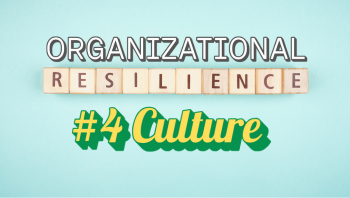Resilience-Dimension 4: Culture
Corporate culture and organizational resilience in organizational development
Let's look outside: the loss of a constructive political culture is crippling democracies. The coarsening of online culture is poisoning discourse. Fragmentation, ego-driven behavior, and constant conflict are sapping our strength as a society.
Silo thinking and power games: cultural obstacles to change management
And inside our companies? Often the same picture, only quieter: departments defend their silos, knowledge is hoarded, cross-departmental projects fail due to power games and a silent refusal to cooperate. But: “We are very polite to each other” – quote from a company's head of strategy. The consequences are devastating, not only for the working atmosphere, but also for the resilience of the entire organization.
Resilience through culture, strategy, purpose, and structure
Because resilience arises from the beneficial interactions between corporate culture, purpose, strategy, and structure, not from Excel sheets or organizational charts. It arises where people stand together in critical moments, support each other, share ideas, and are willing and able to take responsibility. Where a culture of mistrust, isolation, and complacency prevails, this ability breaks down: the company becomes as sluggish, vulnerable, and despondent as its employees.
When culture sabotages change management
What's more, even the best strategy and the smartest new organizational structure will fail if the culture is against it. A corporate culture often determines whether a strategically necessary agile and fast structure can be successfully introduced and implemented in the long term – or whether it exists on paper and withers away in everyday life.
Practical example of organizational development: culture as a resistance factor
Time and again, we see projects where a clearly necessary strategic realignment stalls, even though it is crucial for the financial survival of the entire organization. Here's an example: A company was facing such a realignment. But one central department signaled: “We'll do our part, but we're not participating in this joint, cross-departmental realignment. That's not our responsibility.” This was not based on individual issues, but on a cultural pattern: power struggles, demarcation, and old animosities had become part of the corporate culture over the years. At that moment, it was this culture, not processes or structures, that determined behavior and weakened the common direction. It is precisely such cultural influences that often determine whether an organization is able to act resiliently and sustainably.
Cultural characteristics for sustainable resilience and cooperation
A supportive corporate culture, on the other hand
- allows mistakes to be discussed openly instead of looking for someone to blame
- demands genuine cooperation (including conflict!), even and especially in uncomfortable situations
- connects people across departments and builds trust, even in turbulent times
Six change management levers to promote resilience and leadership culture
Six practical levers that companies can use to strengthen their culture and thus build resilience:
- Live values visibly in everyday work: Don't just print posters; actively discuss in meetings and projects which values are being lived and where they are not. This applies to managers and employees alike!
- Decentralize responsibility: Make (and want to make) decisions where the knowledge is—this strengthens self-efficacy and speed. (But only on the condition that everyone is pulling in the same direction: toward the common strategy!)
- Create space for honest feedback: Establish regular, safe formats in which employees can express criticism and contribute ideas. But also highlight examples of projects, support, and successful collaboration!
- Encourage collaboration: Consciously demand (and promote) cross-departmental projects, define common goals, and recognize and celebrate successes across teams.
- Understand leadership as a relationship: Hold managers and employees equally accountable for building strong relationships and resolving conflicts constructively.
- Embed resilience as part of the corporate strategy: Don't see resilience as a by-product, but actively implement it as a central strategic goal.
Conclusion: Culture as the foundation of resilient organizations
Resilience is not a coincidence. It is the result of attitude and behavior – of a lived culture.
Let's discuss and learn from each other in the comments. 💬
3 ideas for your organization:
✅ Corporate culture and leadership culture as drivers of sustainable resilience
✅ Change management and organizational development need to be anchored in the culture
✅ Six concrete levers strengthen culture, collaboration, and responsibility
Reflection question:
How do you experience the connection between culture and resilience in your organizations? Where do you see the greatest levers? Which of these apply to your organization and where could you take the first step?


About me

All Rights Reserved
Get in touch
-
+49-(0)941 600 93 003
-
This email address is being protected from spambots. You need JavaScript enabled to view it. -
Thomas_Huber
ToChange Gmbh
-
Thomas Huber
-
Traubengasse 6
-
D-93059 Regensburg

